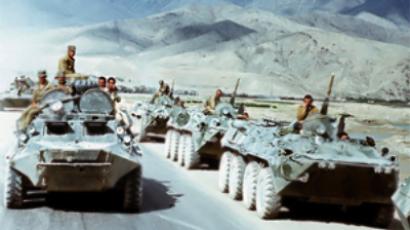Afghanistan: the U.S.-made Soviet trap
It is twenty years since Soviet troops pulled out of Afghanistan. 14,000 Russians and more than a million Afghans were killed in the nine-year war, but these losses failed to secure peace in Afghanistan.
In 1979 Afghanistan was in chaos. Its pro-Soviet government was trying to contain a revolt by religious rebels known as the Mujaheddin.
Help from the Soviet Union was requested. It did not take long as the USSR was willing to protect its influence in the region, but what began as trepid assistance became a full blown war.
Valery Bochkov, a former KGB Advisor in Afghanistan, remembers the first days of the war. He says the Soviet army was met with flowers:
“I can’t say that we felt like occupants,” he recalls. “We had a long history with Afghanistan. I have relatives who lived there and I still keep in touch with people I met there.”
No one expected the war to go on for a decade. Over 14,000 men would die, and almost half a million would be wounded or become sick. The majority of casualties were due to poor sanitary conditions. In addition the local climate was much different to what soldiers were used to back home.
Many say the war in Afghanistan was the beginning of the end for the Soviet Union.
The U.S., who felt it was losing its grip on the region, was brewing a policy to promote radical Islamist and anti-communist forces. By raising the political and military costs of the war in Afghanistan for the USSR, the U.S. hoped it would gain the upper hand in the Cold War.
“If the U.S. didn’t support the Mujaheddin regime, none of it would have happened,” believes Valery Bochkov.
In fact, that was the U.S. plan: a trap. Code-named Operation Cyclone and funded by the CIA – it was designed to draw the USSR into an expensive and distracting war, much like America’s experience in Vietnam.
The arming of the Afghan Mujaheddin lead by Ahmad Shah Massoud was one of America’s most expensive covert operations ever. The budget ranged from $US 30 million a year to $US 630 million in 1987.
Ahmad Shah Massoud was a popular anti-Soviet resistance leader widely supported by the west. He went on to become a national hero. In 2001 he was assassinated by suspected Al-Qaeda agents, and a year later was nominated for the Nobel peace prize.
However, peace never came to Afghanistan. The Mujaheddin made way for the Taliban, and the Taliban welcomed Osama Bin Laden.
The Soviet Union realised it had got dragged into a war impossible to win. In 1988 the final troop withdrawal began.
Twenty years since the end of the Soviet-Afghan war, the U.S. now ironically finds itself fighting against the very movement it helped arm, in a country that is still crippled by chaos two decades on.













